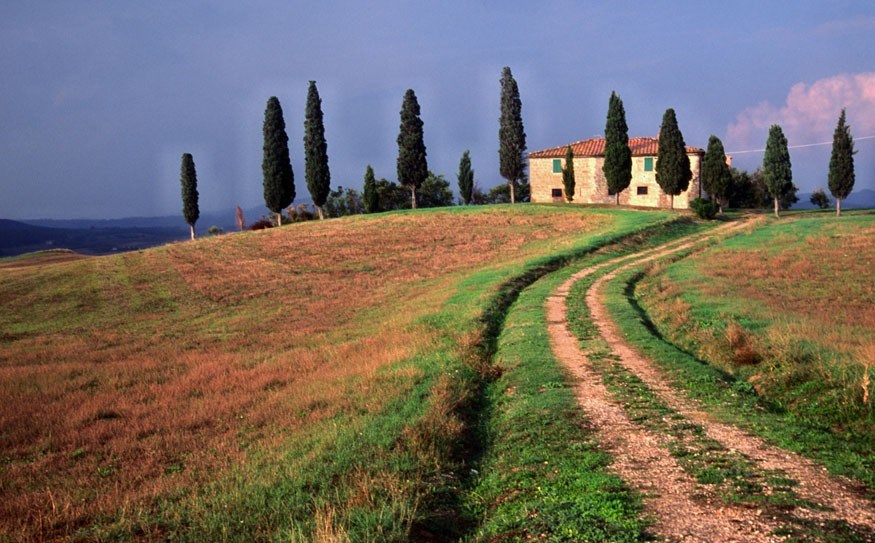Permeated with patterns of seasonal crops, cypress spires and harvest colours, the iconic Tuscan landscape emphasizes harmony and balance within an agricultural context. More agriscape than landscape, this part of the world celebrates the lay of the land and the production of food and wine in ways that are healthy, wholesome, and sustainable.
The Tuscan agriscape is a special region known for its surrealistic light; imparting a gossamer-like quality that softens contrast while infusing an angelic glimmering glow to the land. Perhaps this is why painters, photographers, and writers flock to the countryside, so that they can see the world through a new light, through different eyes. Tuscany does that for those who come.
In the heart of this region, not far from the medieval city of Siena, is Tenuta di Spannocchia, an agritourism retreat that combines farm living with overnight lodging and great food so that guests can experience a return to the land. It is a place where self-sustaining organic agriculture is not only practiced, but the harvested food is prepared and served at meals to the many guests at Spannocchia — from photographers, farmers, and foresters to writers, artists and actresses. Organically produced ingredients from the property include wine, olive oil, vegetables, grains, breads, and honey.
Tuscany Through the Lens
I came to Tuscany as a student of photography, hoping to capture the ethereal quality of light through my lens. I would spend a week photographing with my buddy Darren, looking to capture beautiful images of the Tuscan landscape.
During the week we stretched our vision, unlocked our creativity, and focused our inner eye so as to capture the essence of this secret, magical place. Whether macro for details or telescopic for big landscapes, by the end of the week, our images virtually sparkled with spirit.
After all, subject matter is everywhere; you only need to open your eyes to see. Mark Twain understood the need for the creative muse, when he said, "You cannot depend on your eyes when your imagination is out of focus." The key is to look for the extraordinary in the everyday. From vases of flowers that look like Rembrandt paintings, luscious lemons on trees and in bowls, roaming kittens, organic crops, beneficial blooms, and heirloom animals; the photographic possibilities are endless.
The Agriscape at Spannocchia
Spannocchia is about organic and sustainable agriculture; it's about living in harmony with the land, about rediscovering heirloom foods for quality and taste, about preserving animal and plant biodiversity, and about preserving agricultural and cultural heritage for future generations. In practicing sustainable agriculture, the Spannocchia Foundation states that:
"... crops feed the animals, the animals produce the manure that is used to fertilize the fields to grow the next cycle of crops, the animals and crops feed the human residents and visitors, and the humans provide the labour necessary to make it all work."
Once a medieval stronghold, Spannocchia traces its history to around the 12th century, the same time its bell tower was constructed. For over 800 years, it remained an agricultural estate (Tenuta), owned by the powerful Spannocchi family. The tenant farming or sharecropping system, not only defined rural Tuscany but inadvertently preserved the agriscape until shortly before the Second World War, when new technologies and improved communications made it obsolete. For the first time in centuries, Tuscan land changed ownership through a combination of land and estate sales. This is when Tenuta di Spannocchia was sold to Delfino Cinelli in 1925. Spannocchia is now run by the great granddaughter, Francesca Cinelli and her husband, Randall Stratton.
The Spannocchia Foundation was created in 2002 to offer educational and research opportunities while hosting various seminars and workshops on site, and providing housing and meals to guests. The Foundation seeks to encourage global dialogue about sustaining cultural landscapes for future generations.
The Gift of Spannocchia
Perhaps the most valuable gift you take from Spannocchia is the gift of renewal and an appreciation for the interconnectivity of life. This lesson is best demonstrated through sustainability programs as practiced at Spannocchia that embody the concept of "slow food" and "slow travel." This simply is defined as those who take the time to experience the land and food, the people and culture with dimension and depth rather than through superficial samplings of their surroundings.
The gift of Spannocchia is the opportunity to experience local food, culture, and history as part of a global understanding on the importance of individual stewardship and community involvement. Take the time to visit this unique piece of history for an agritourism and agriscape experience you will never forget.




